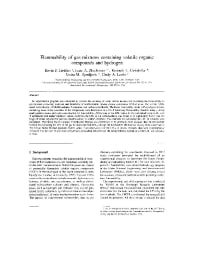Mining Publication: Flammability of Gas Mixtures Containing Volatile Organic Compounds and Hydrogen
Original creation date: May 2000
Authors: KJ Liekhus, IA Zlochower, KL Cashdollar, SM Djordjevic, CA Loehr
NIOSHTIC2 Number: 20020734
J Loss Prev Process Ind 2000 May 13(3-5):377-384
An experimental program was conducted to evaluate the accuracy of some current methods for predicting the flammability of gas mixtures containing hydrogen and flammable or nonflammable volatile organic compounds (VOCs) in air. The specific VOCs tested were toluene, 1,2-dichloroethane, 2-butanone, and carbon tetrachloride. The lower flammability limits (LFLs) of gas mixtures containing equal molar quantities of the components were determined in a 19.4-1 laboratory flammability chamber using a strong spark ignition source and a pressure criterion for flammability. All but one of the LFL values for the individual components were in agreement with earlier literature values. However, the LFL of 1,2-dichloroethane was found to be significantly lower than the range of values reported for previous determinations in smaller chambers. Two methods for calculating the LFL of mixtures were considered. The Group Factor (atomic) Contribution Method was determined to be generally more accurate than the LeChatelier Method for estimating the LFL of the gas mixtures reported here, although the LeChatelier Method was usually more conservative. The Group Factor Method predicted higher values (nonconservative) for the LFLs of several mixtures than were experimentally measured. For the case of a mixture of hydrogen and carbon tetrachloride, the Group Method estimation of the LFL was seriously in error.

NIOSHTIC2 Number: 20020734
J Loss Prev Process Ind 2000 May 13(3-5):377-384
- A 20-Liter Furnace Test Method to Determine the Combustion Gas Toxicity of Conveyor Belts
- Comparing Measurements of Carbon in Diesel Exhaust Aerosols Using the Aethalometer, NIOSH Method 5040, and SMPS
- Effect of Air Velocity on Conveyor Belt Fire Suppression Systems
- Explosion Temperatures and Pressures of Metals and Other Elemental Dust Clouds
- The Fate of Metal (Fe) During Diesel Combustion: Morphology, Chemistry, and Formation Pathways of Nanoparticles
- Flammability of Methane, Propane, and Hydrogen Gases
- The Limiting Oxygen Concentration and Flammability Limits of Gases and Gas Mixtures
- Rapid Sampling of Products During Coal Mine Explosions
- Role of Lubrication Oil in Particulate Emissions from a Hydrogen-Powered Internal Combustion Engine
- Sampling Results of the Improved SKC� Diesel Particulate Matter Cassette